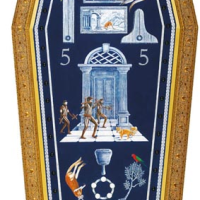59. DANIE MELLOR

Danie Mellors win in the 2009 National Aboriginal and Torres Strait Art Award caused a media sensation. Not only was he just the third urban artist to win the award, for some of the more extreme tabloid commentators he was not a proper Aboriginal wrong colour hair and eyes, too white, too articulate and too well educated to be a real draw-in-the-dirt Indigenous artist. The furore was typical of many such moments when the very definition of Aboriginality comes into question. But Danie Mellor is sure and confident of his place in the world; a respected academic, a strong contributor to the broader arts scene with a seat on the Australia Council and an artist who has received just praise and recognition both in Australia and internationally.
Born in the North Queensland city of Mackay in 1971, Mellor moved around the country, as well as South Africa, before settling in Canberra. He is highly educated in both the theory and practice of art, with an MFA from Birmingham School of Art and a PhD from the Australian National University. It is therefore not surprising that the work he produces is subtle and nuanced, with inputs from many cultures, traditions and belief systems. He works in both two and three dimensions, creating elegantly crafted works in which the powerful political message is often masked behind a masterly display of design and execution.
Drawing on his deep knowledge of western art and cultural tradition, Mellor turns the symbols and history of the British colonial masters back on themselves, showing the arrogance of their stance and shallowness of their beliefs. He has settled on the use of blue and white as a way of referencing back into a cultural tradition that has deep resonance in the colonisation of Australia. In the late eighteenth century the wealthy classes of Great Britain were acquiring a taste for the blue and white ceramics being manufactured by the British potteries that thrived in the industrial revolution. They in turn had learned the mode from the Dutch potters of Delft and the Chinese export ware that was being shipped in large quantities to the UK and America. The Willow Pattern was as recognisable in Britain as it was in China. It represented a new form of cultural appropriation which, when mixed with efficient industrial production, began to permeate the so-called civilised world. Mellor took the forms and imagery of blue and white and contrasted it to full colour images of Australia, its people, fauna and flora. Rather than use traditional Aboriginal forms of expression, he took the illustrative style used by the scientists, artists and anthropologists who were combing the new land for the exotic and bizarre, new finds to surprise their audiences at the Royal Society back in London.
Just as the explorers and colonists, the invaders of the new land, sought to explain the lives of the Indigenous people, their beliefs and customs, so Mellor has looked at the belief systems of those same people. He has created a series of works using the imagery and symbolism of Freemasonry, a powerful force that blossomed in the late eighteenth century. Masonic rites and practices involved highly structured symbols, which have set meanings in every aspect of the craft. Mellors 2009 prize winning work From Rite to Ritual sees a group of charming native animals wandering around a beautifully rendered blue and white image of the interior of a masonic temple. In A Trace of History (of Death and Resurrection), Mellor takes us deeper into the Masonic world, depicting in accurate detail the Tracing Board of the Third Degree of Freemasonry. Such boards were traditionally used to both instruct and test members as they advanced through the levels of the craft to reach induction as a Master Mason.
The artist has produced a jewel encrusted and richly decorated interpretation, with the symbols picked out in glitter and Swarovsky crystals. The symbols of the Craft, the divider, mallet, plumb line and level, which have deep meaning at the centre of Freemasonry, sit alongside the skull and crossbones, the symbol of mortality. The repeated numeral five is symbolically linked to the letter G, standing for God and for the divine geometry that rules our lives. No labour has been spared in producing this beautiful rendition of the arcane symbols, which are then playfully set against a mob of kangaroos relaxing upon the rich blue ground. Three naked Aboriginal warriors guard the doors to the Temple of Solomon, challenging two young dingo pups, just as new initiates are challenged at the door of the lodge. Mellor has equipped the warriors with the distinctive crossed boomerangs of his own people from North Queensland, referencing the crosses that abound in Masonic ritual. In producing such a detailed and finely crafted work, Mellor is challenging the very bases of western culture, stating with subtelty and not a little humour, that you have your absurd beliefs, just as we have our own way of seeing our world give us the respect and understanding you demand for yours.
Gavin Fry BA (Hons), MA, M.Phil.